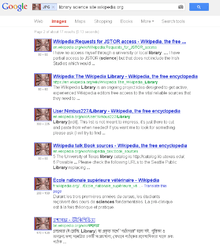Reverse image search

Reverse image search is a content-based image retrieval (CBIR) query technique that involves providing the CBIR system with a sample image that it will then base its search upon; in terms of information retrieval, the sample image is what formulates a search query. In particular, reverse image search is characterized by a lack of search terms. This effectively removes the need for a user to guess at keywords or terms that may or may not return a correct result. Reverse image search also allows users to discover content that is related to a specific sample image,[1] popularity of an image, and discover manipulated versions and derivative works.[2][3]
Uses
Reverse image search may be used to:[4][5]
- Locate the source of an image
- Find higher resolution versions
- Discover webpages where the image appears
- Track down the content creator
- Get information about an image
Algorithms
Commonly used reverse image search algorithms include:[6]
- Scale-invariant feature transform - to extract local features of an image [7]
- Maximally stable extremal regions
- Vocabulary Tree
Application in popular search systems
Google Images
Google's Search by image is a feature that utilizes reverse image search and allows users to search for related images just by uploading an image or image URL. Google accomplishes this by analyzing the submitted picture and constructing a mathematical model of it using advanced algorithms.[8] It is then compared with billions of other images in Google's databases before returning matching and similar results. It should be noted that when available, Google also uses metadata about the image such as description.
TinEye
TinEye is a search engine specializing in reverse image search. Upon submitting an image, TinEye creates a "unique and compact digital signature or fingerprint" of said image and matches it with other indexed images.[9] This procedure is able to match even heavily edited versions of the submitted image, but will not usually return similar images in the results.[10]
Pinterest acquired startup company VisualGraph in 2014 and introduced visual search on its platform.[11] In 2015, Pinterest published a paper at the ACM Conference on Knowledge Discovery and Data Mining conference and disclosed the architecture of the system. The pipeline uses Apache Hadoop, the open-source Caffe convolutional neural network framework, Cascading for batch processing, PinLater for messaging, and Apache HBase for storage. Image characteristics, including local features, deep features, salient color signatures and salient pixels are extracted from user uploads. The system runs on Amazon EC2, and only requires a cluster of 5 GPU instances to handle daily image uploads onto Pinterest. By using reverse image search, Pinterest is able to extract visual features from fashion objects (e.g. shoes, dress, glasses, bag, watch, pants, shorts, bikini, earrings) and offer product recommendations that look similar.[12][13]
Research systems
Microsoft Research Asia's Beijing Lab published a paper in the Proceedings of the IEEE on the Arista-SS (Similar Search) and the Arista-DS (Duplicate Search) systems. Arista-DS only performs duplicate search algorithms such as principal component analysis on global image features to lower computational and memory costs. Arista-DS is able to perform duplicate search on 2 billion images with 10 servers but with the trade-off of not detecting near duplicates.[14][15]
Production reverse image search systems
- Google Images
- Bing
- LAPIXA
- Reverse image Search for Android phones
- picMatch
- Reverse Image Search with Google, Bing and Yandex
- Pixsy
- Mypicguard
- Reverse Image Search
- Resolution Foundry
- ImageWiki
- Other systems: Dotegy Reverse Image Search, Yandex Images and Karma Decay
- Reverse Image Search Windows Phone App powered by Google, Bing, Tineye and Yandex
- Anime-related: Multi-Service image search, SauceNAO Image Search, WAIT: What Anime Is This?
See also
References
- ↑ "How to search by image". Google. Retrieved 2 November 2013.
- ↑ "Find Your Images Online Using Reverse Image Search on Google". PhotoShelter Blog.
- ↑ "Video searching with Frompo". Frompo.com. Retrieved 2 November 2013.
- ↑ "MAKING A MARK". makingamark.blogspot.com.
- ↑ "FAQ - TinEye - Why use TinEye?". TinEye.
- ↑ Bundling Features for Large Scale Partial-DuplicateWeb Image Search Microsoft.
- ↑ A New Web Image Searching Engine by Using SIFT Algorithm computer.org
- ↑ "How does Google's reverse image search work? - Quora". quora.com.
- ↑ "FAQ - TinEye - How does TinEye work?". TinEye.
- ↑ "FAQ - TinEye - Can TinEye find similar images??". TinEye.
- ↑ Josh Constine. "Pinterest Acquires Image Recognition And Visual Search Startup VisualGraph". TechCrunch. AOL.
- ↑ "Visual Search at Pinterest". acm.org.
- ↑ "Building a scalable machine vision pipeline". Pinterest Engineering.
- ↑ Duplicate-Search-Based Image Annotation Using Web-Scale Data Microsoft.
- ↑ "Arista - Dr. Xin-Jing Wang's Homepage". Google.